077: The Irish Economy 100 years on from the 1916 Easter Rising
This is a commemorative episode celebrating the 100 year anniversary of Ireland’s 1916 Easter Rising in which the Proclamation of the Republic was read by Padraig Pearse at four minutes past noon on Easter Monday, April 24th, from the steps of the General Post Office on Sackville Street (now known as O’Connell Street). The document proclaimed Ireland’s independence from Great Britain.
How was Ireland’s economy performing in 1916 and how far have we come 100 years on?
Background:
Ireland in 1916, consisting of 32 counties, was ruled by Great Britain. The 32 county economy experienced a period of unprecedented prosperity mainly due to the positive economic effects of the First World War.
However, since the Great Irish Famine of 1846, Ireland experienced mass emigration and large numbers of deaths. The laissez-faire economic ideology was a failure. From the period 1851 to 1916, over 5 million Irish citizens emigrated reducing the population from a peak of approximately 8 million to 3 million.
The Irish economy was ruled by Great Britain and its economy became increasingly tied to trends in global markets. The cost of living increased and there were some rises in living standards. These were subject to sharp declines due to the recessions of 1859 to 1863 and 1877 to 1880. Poverty was widespread and tensions between landlords and tenant farmers escalated. Despite this poverty, Irish living standards were above most of Eastern and Central Europe but income levels remained below the UK and the US.
Ireland’s economy became increasingly reliant on four main industries: Agriculture, Linen production, Shipbuilding (where the Titanic was built) and Brewing and Distilling. However, agricultural exports were heavily dependent on Great Britain and Shipbuilding was dependent on an outdated industry. For example, it wasn’t long after the First World War that the Irish Shipbuilding industry collapsed.
The First World War of 1914 brought about a period of prosperity for Ireland, due to the increased demand for food, linen and ships that were directly linked to the war effort. However, this prosperity was not shared by all.
So what did the Irish economy of 1916 look like compared to its economy today 100 years on?
Source: Central Statistics Office
Population:
The population of Ireland in 1916 was one of the lowest recorded in its history. According to the population census of 1911, the population stood at just 3.14 million. It represented a country devastated by death caused by the famine over a half century previous and the subsequent mass emigration that ensued.
A 9-year-old Irish immigrant laborer shucks oysters in front of his foreman in the U.S. in 1911. pic.twitter.com/cOKICWk8Ta
— HISTORY (@HISTORY) April 12, 2016
Today, Ireland’s population has recovered to 4.59 million, an increase of 46%. However, many have emigrated due to the financial crisis of 2007, most notably Ireland’s youth. We have reverted to being a net emigration population after a period of becoming a net immigration population, attracting workers from overseas as well as bringing Irish people home.
Emigration for the whole island of Ireland in 1916 was 7,366 or 17 per 10,000 of the population. This had fallen from a substantial level before the outbreak of the Great War. The latest data for 2015 shows emigration for the Republic of Ireland at 80,900 representing 175 per 10,000 of the population.
Emigration in 1916 consisted of 5,580 females and only 1,786 males. This I found surprising.
The four main destinations for Irish emigrants in 1916 were the US, the UK, Canada and then Australia.
In 2015, the UK was the main destination for Irish emigrants. Only 7% of emigrants went to the US in 2015 compared to 58% emigrating in 1916.
The Irish diaspora abroad is quite large. Despite being a small island off Western Europe, Irish smiles have been welcomed all over the world. Ancestry can be traced back to Ireland particularly for those living in the United States, the UK, Argentina, Australia and Canada.
Today, it is estimated that there are 80 million people of Irish descent living around the world today. Other that the Republic of Ireland and Northern Ireland, Montserrat in the Caribbean is the only other country where St. Patrick’s Day is a public holiday.
Montserrat is known as the Emerald Isle of the Caribbean and it’s Irish heritage dates back to the 17th century when the island became a safe haven for the Irish who were originally sent to the Caribbean as slaves by Great Britain’s leader Oliver Cromwell. A census in 1678 showed that more than half of the population on the island were Irish.
Life Expectancy:
According to records for 1911, the life expectancy for a male born in Ireland was 53.6 years and for a female 54.1 years. Today, a male born in Ireland has a life expectancy of 78.3 years and a female 82.7 years.
Despite the period of prosperity, Ireland remained divided in terms of the gap between wealth and poor. Much of rural Ireland in the west of the country lived as an agrarian society, dependent on agriculture for a living. Living standards were much lower relative to other parts of the country.
Urban areas did not escape the ravishes of poverty. Inequality was more prevalent in urban towns, particularly in Dublin city. Despite a boom in food and linen exports in 1916, the Irish poor remained hungry.
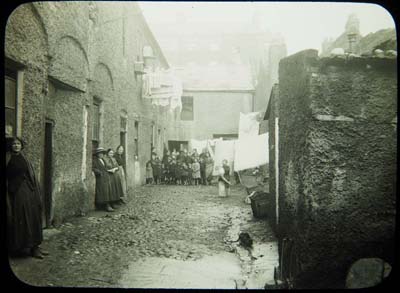
Henrietta Place, Dublin 1913. The flight of wealth to the suburbs often meant an escape from inner city squalor.
Poverty levels in Ireland today are at 8% with households consisting of one adult and one or more dependent children considered most at risk. Rural Ireland, including the West of Ireland, has a higher incidence of poverty than the rest of the country. As the saying goes, things change but always stay the same!
Many adults and children perished due to influenza, bronchitis and tuberculosis. These were the leading causes of death in Ireland along with heart disease. Today, heart disease is the leading cause of death in Ireland with few incidences of death from the other forms. The number of deaths by suicide that was officially recorded in 1916 were 68 compared to 459 for 2014, This represented 10 per 100,000 of the population compared to approximately 2 per 100,000 of the population.
Housing:
Ireland’s macro economy of 2016 is showing remarkable progress since it’s recession, bailout and financial crisis. The Irish have a love affair with housing. Perhaps it has its roots in history where many people were evicted from their homes during the Great Irish Famine.
During the boom from 1998 to 2007, Irish house prices soared only to come crashing down once the crisis hit. At its peak, over 90,000 houses were built but today only 11,000 houses were completed. The Irish housing market is under immense stress with demand outstripping supply. This shortage is resulting in much higher rents than what was recorded during the boom period. House prices are recovering but recent government legislation is making it difficult for landlords who are selling their property or evicting their tenants in order to capture the higher rental yields. Ireland is undergoing a housing crisis in today.
In 1916, Ireland experienced a severe housing crisis. Dublin and other cities became infamous for the living conditions of its citizens. The tenements, where many impoverished families lived, marked a bleak period in recent Irish history.
Multiple families shared large terraced houses with extremely poor sanitary and hygiene conditions. It was estimated at the time that 20,000 families in Dublin occupied single rooms and in some cases with other families. Family sizes of 8 or 10 children were not unusual. There were cases of 104 people occupying a single house built to accommodate one family.
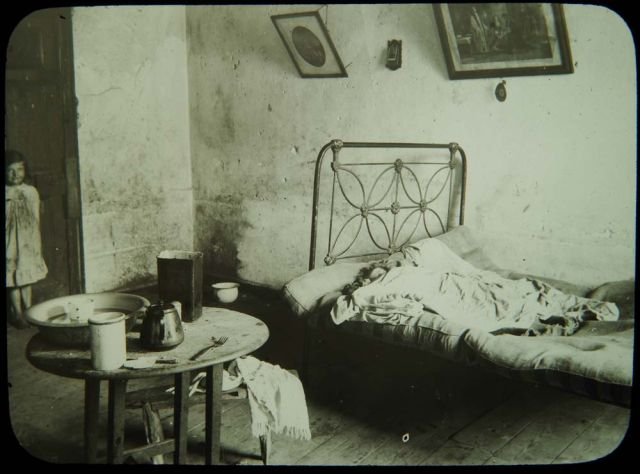
A Tenement Room on Francis Street, Dublin in 1913
Many evictions took place as families fell behind in rent. Facing starvation, children queued for bread which was handed out by religious orders. Many people in the West of Ireland emigrated due to food shortages and abandoned their homes. Despite many empty homes in the rural parts of Ireland, many families suffered homelessness, extremely poor living conditions and starvation.
Due to the housing crisis that Ireland is experiencing today in 2016, there are some echoes of the past. Homelessness has jumped 100% since January 2015. Over 700 families are living in emergency accommodation in hotels and guest houses. Evictions are up significantly and there are currently 17,000 people in the courts who are at risk of losing their homes. Food parcels are being handed out each week and the number queuing is rising.
Employment:
The Irish economy in 1916 was transitioning toward becoming an industrial nation. It was by no means considered backward and was in fact placed in the group of middle-ranking industrialised countries along with the Netherlands, the Scandinavian countries, Italy and Portugal. 26.8% of workers in 1911 worked in manufacturing jobs compared to 8.6% in 2011.
An estimated 150,000 men had joined the British army and many men and women went to the UK to find employment in munition factories and hospitals. Wages had increased during this time.
Almost 50% of the working population were employed in the Agriculture sector in 1911. This compares to just 4.9% in 2011.
In 1911, 8.8% of the labour force in Ireland worked in the professional group of occupations. By 2011, these workers now account for over 40% of the Irish workforce.
Ireland’s unemployment rate today is 8.8% coming from a recent high of 14.4%. It is unsure what the level was in 1916.
Exports:
Ireland in 1916 mostly consisted of indigenous industries. 85,000 workers were employed in linen production with over 18 million pounds (weight) of linen yarn and 112 million pounds (weight) of finished linen goods exported. Prior to the outbreak of World War I in 1914, about 70% of these exports were to the United States of America. However between 1914 and 1918, linen was in great demand for military purposes by the British Army for items such as tents, haversacks, hospital equipment and aeroplane fabric.
Today much of its traditional industry gone today. Very few linen manufacturers and weavers exist today. To bring my own personal family history into this story, my family remains one of a few linen weavers in Ireland today, producing the best Irish linen in the market with exports to countries that include Japan, the US and Italy. I’m personally proud of my father for what he has achieved and for extending the Irish tradition of producing the finest linen in the world.
Ireland is considered a small open economy and the UK still remains one of our largest trading partners. The Irish economy attracts many multinationals companies to locate here. In 2016, Ireland ranks among the top countries regarding industrial competitiveness and ease of doing business.
The Guinness brewery was the main brewery in Ireland and in 1916 it had the largest output of any brewery in the world, brewing more than two-thirds of all beer brewed in Ireland.
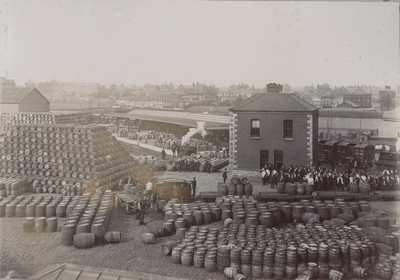
Cask Yard St. James’ Gate Brewery 1906 – 1913
The largest exporting sectors in Ireland during 1916 were woollens, brewing, butter, bacon, poultry, cattle, cotton goods and linen. The sectors that were in decline included horses, whiskey, pigs and sheep.
Ireland had a trade surplus of 1.5 million pounds (and a balance surplus of 11.1 million pounds) in 1916. For the latest data today, which is January 2016, Ireland is operating a trade surplus of 4.99 billion euro. Ireland’s largest exporting sectors are Medical and pharmaceutical products (representing 27% of total exports), Office machines and automatic data processing machines, and Food and live animals (representing 7.8% of our total exports).
The EU accounts for 56% of the total value of Irish goods exported. Belgium is Irelands largest export trading partner accounting for 15% of the total value of goods exported.
Great Britain remains Ireland’s single largest source of imports with 25% of the total value of goods imported to Ireland.
The USA remains Irelands largest non-EU destination for exports and imports.
GDP:
According to research by Kevin O’Rourke of the Department of Economics at University College Dublin a proxy measure for GDP per capita in Ireland was estimated to be 32.50 in 1913. This was based on a GDP estimate of 150 million. To put this into some context, the estimated GDP per capita in 1864 was 12.50 with GDP estimated at 60 million – over a 160% increase in nominal terms between the Famine and the Great War. Irish GDP per capita converged on the UK average during this time.
According to the International Geary-Khamis dollars, Ireland’s GDP per capita in 1913 was $2,736 whereas the US GDP per capita was $5,301 and the UK’s at $4,921, almost twice that of Ireland’s. This seems to suggest that incomes had yet to converge with those in Great Britain.
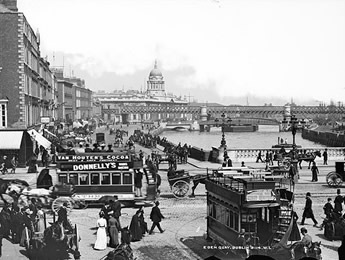
Eden Quay displays the bustle of turn of the century Dublin city life
Ireland would have been considered one of the poorest Western European countries along with Greece, Italy, Portugal and Spain – yes there’s that familiar acronym of the financial crisis.
Today, Ireland is considered one of the richest countries in the world with GDP per capita of just under $49,000, placing the country in 10th position, with the US in 9th and the UK in 19th according to the World Bank.
GDP for Ireland was $11.9 million but this collapsed to $7.8 million by 1921 perhaps due to the Irish civil war. It was only in 1960 that Ireland recovered to pre-1916 levels.
There were 9,850 cars registered in Ireland in 1915 with now over 2 million registered today.
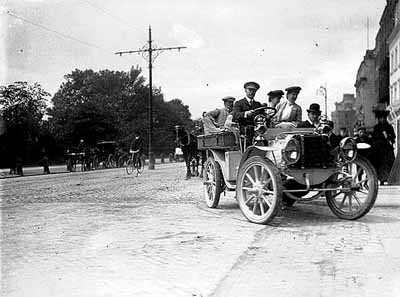
Inflation:
Due to the outbreak of the First World War in 1914 and the resulting scarcity of goods, inflation in Ireland increased considerably by 200% over the wartime period as measured by the wholesale price index.
Unless wage inflation was outpacing price inflation in 1916, which is very unlikely, families must have experienced a real reduction in the purchasing power of their £.
These increases in prices were also due to Government policy which increased taxes and duties on various products.
The retail price of butter, tea and eggs were expensive in 1916. For example, the price of a pound of butter then would have cost 7 euro 35 cent updated to today’s consumer price index compared to today’s price of 2 euro 79 cent.
Links:
- Data: Central Statistics Office
- Data: International Geary-Khamis dollars by Professor Angus Maddison
- Paper: Monetary Data and Proxy GDP Estimates: Ireland 1840 – 1921 by Kevin O’Rourke, UCD.
- Read Ireland’s Proclamation of the Republic where equal rights for all men, women and children was declared along with the creation of a sovereign country.
Family History Research:
- Ireland’s Census: Search for your Irish Heritage for the following Census years: 1911, 1901, 1851, 1841, 1831 and 1821.
- National Library of Ireland: www.nli.ie
Images:
- All images courtesy of the National Library of Ireland
- Infographic courtesy of the Central Statistics Office
Podcast: Play in new window | Download
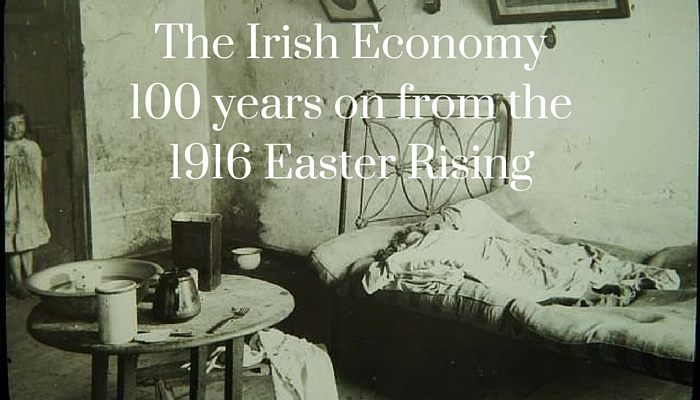

 152: David Kyle Johnson on Economics and Philosophy in Soylent Green
152: David Kyle Johnson on Economics and Philosophy in Soylent Green 053: Helena Norberg-Hodge on Localisation, Trade Treaties and the Economics of Happiness
053: Helena Norberg-Hodge on Localisation, Trade Treaties and the Economics of Happiness 113: Jonathan McEvoy on Globalisation, National Autonomy, Capitalism and the Economic Resonance in Timeless Songs
113: Jonathan McEvoy on Globalisation, National Autonomy, Capitalism and the Economic Resonance in Timeless Songs 083: Stephen Kinsella on Stock Flow Models, Rent Controls and Being the Green Lantern of Economics
083: Stephen Kinsella on Stock Flow Models, Rent Controls and Being the Green Lantern of Economics 074: Peter Leeson on The Invisible Hook: The Hidden Economics of Pirates
074: Peter Leeson on The Invisible Hook: The Hidden Economics of Pirates 103: Brian Mills on the Labor Market in Baseball, the Umpire Strikes Back and R
103: Brian Mills on the Labor Market in Baseball, the Umpire Strikes Back and R 149: Soumaya Keynes on Tariffs, Trump and Trade Agreements
149: Soumaya Keynes on Tariffs, Trump and Trade Agreements 085: Michael Roberts on Understanding Karl Marx and His Thinking on Capitalism
085: Michael Roberts on Understanding Karl Marx and His Thinking on Capitalism 087: Asgeir B. Torfason on the Economy of Iceland and Explaining Negative Cashflows in Banks
087: Asgeir B. Torfason on the Economy of Iceland and Explaining Negative Cashflows in Banks 095: Scott Burns on Mobile Money Banking in Africa and the Success of M-Pesa
095: Scott Burns on Mobile Money Banking in Africa and the Success of M-Pesa
 David Zetland
David Zetland
April 1, 2016 at 1:42 pmNice long term perspective. I’d have put more emphasis on Ireland’s emergence from colonialism as a means to its current prosperity, esp. since joining the EU and embracing free trade.
That said, I disagree that housing should be “affordable” relative to 2007, when Ireland was in a building bubble and prices were too high and rents too low (simultaneously?)
I suggest looking at many prices (rent, butter) in terms of purchasing power, as that compares average wages to current prices, e.g., hours/days of work to pay average rent, etc.
On the “huge” disapora, it kinda makes sense when people claim to be irish with 1/16 ancestry (let alone DNA). Using the same measure, we might have 7.5*16 = 120 billion “descendents” of varous places 🙂
Last, I was AMAZED by the nunnery stats. I’d guess that health and education costs have risen but many women are probably happy to be doing other things 🙂
 Frank
Frank
April 1, 2016 at 10:31 pmHi David. Thanks for the comment and feedback. It was only after I released this episode that I realised the meaning behind the ‘nunnery’ stats. We have a shameful history in how we treated young women in the 20th century. There was a sudden rise in the number of convents that were being built from the early part of the 20th century and this continued into the 1950s and 1960s. Many young women, including those who became pregnant out of wedlock and those whose mothers died and their fathers couldn’t look after them, were sent to these convents to work. These institutions were asylums and the nuns, under the guidance of the Catholic Church and in collusion with the State, treated the girls and women as prisoners for an indefinite amount of time (some for their lifetime). They worked in the many laundries around Ireland, the most controversial being the Magdalene laundries. These women were slaves to the nuns who treated them terribly and punished them physically, sexually, emotionally and spiritually. Revelations of the ‘forgotten women of Ireland’ only came to light in the 1990s when mass graves were found at some of the sites. Some women came forward. The State formally apologised in 2013 with compensation of 50 million euro awarded to those survivors affected. The Catholic Church has refused to contribute to this day and many are in self-denial. Sad.
Some links:
http://www.magdalenelaundries.com/index.htm
Documentary: Sex in a Cold Climate
Movie: The Magdalene Sisters